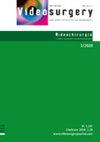Enhanced recovery after surgery in patients undergoing laparoscopic partial nephrectomy. Results from a real-world randomized controlled trial
IF 1.6
4区 医学
Q2 SURGERY
引用次数: 2
Abstract
Introduction Enhanced recovery after surgery (ERAS) is a set of perioperative interventions to alleviate patients’ stress response and complications, and to promote rehabilitation. Data on its implementation in renal cell carcinoma treated by laparoscopic partial nephrectomy are lacking. Aim To evaluate the prospect of application of ERAS in laparoscopic partial nephrectomy based on real-world data. Material and methods Sixty patients with T1a staging renal cell carcinoma (RCC) were randomly classified as the ERAS group (31 patients) or traditional treatment group (29 patients). Relevant endpoints including postoperative length of stay, ambulation, fart, oral intake, pain at different movement and time points, postoperative nausea and vomiting, complications as well as hospitalization expenses in the two groups were analyzed and compared. Results The ERAS optimization group presented a shorter time of first-time ambulation (p = 0.008), less pain at rest and ankle movement (p < 0.05), and less feeling of nausea 2 and 4 h after surgery (p = 0.006 and 0.027, respectively). (Although the differences in hospitalization expenses, postoperative length of stay, and complications were not reached in our study (p > 0.05), they were significantly lower than those reported in other literature. Conclusions The idea of ERAS has had an imperceptible influence on clinical strategy making for over 20 years. This study shows that it could alleviate postoperative pain both at rest and movement, enable earlier walking, and reduce postoperative nausea in patients who have undergone laparoscopic partial nephrectomy. However, its efficacy is sometimes over-extended when compared to extreme conserative. Also, specific ERAS protocols and large-sample clinical trials are needed.腹腔镜肾部分切除术患者术后恢复增强。真实世界的随机对照试验结果
引言术后增强恢复(ERAS)是一套围手术期干预措施,旨在缓解患者的压力反应和并发症,并促进康复。关于腹腔镜肾部分切除术治疗肾细胞癌的实施数据缺乏。目的基于真实数据评估ERAS在腹腔镜部分肾切除术中的应用前景。材料与方法将60例T1a期肾细胞癌(RCC)患者随机分为ERAS组(31例)和传统治疗组(29例)。分析比较两组患者术后停留时间、活动、放屁、口服量、不同运动和时间点疼痛、术后恶心呕吐、并发症及住院费用等相关终点。结果ERAS优化组首次行走时间更短(p=0.008),休息和踝关节运动疼痛更少(p<0.05),术后2小时和4小时恶心感更少(分别为p=0.006和0.027)。(尽管在我们的研究中没有达到住院费用、术后住院时间和并发症的差异(p>0.05),但它们显著低于其他文献中报道的差异。结论20多年来,ERAS的理念对临床策略制定产生了潜移默化的影响。这项研究表明,它可以减轻腹腔镜肾部分切除患者术后休息和运动时的疼痛,使其能够更早地行走,并减少术后恶心。然而,与极端保守主义相比,它的功效有时会被过度夸大。此外,还需要具体的ERAS方案和大样本临床试验。
本文章由计算机程序翻译,如有差异,请以英文原文为准。
求助全文
约1分钟内获得全文
求助全文
来源期刊
CiteScore
2.80
自引率
23.50%
发文量
48
审稿时长
12 weeks
期刊介绍:
Videosurgery and other miniinvasive techniques serves as a forum for exchange of multidisciplinary experiences in fields such as: surgery, gynaecology, urology, gastroenterology, neurosurgery, ENT surgery, cardiac surgery, anaesthesiology and radiology, as well as other branches of medicine dealing with miniinvasive techniques.

 求助内容:
求助内容: 应助结果提醒方式:
应助结果提醒方式:


